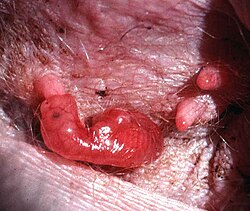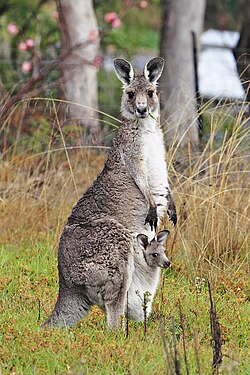|
|
| (One intermediate revision by the same user not shown) |
| Line 1: |
Line 1: |
| − | {{Taxobox
| + | [[Image:Joey in pouch.jpg|right|thumb|180px|Kangaroo joey inside the pouch]] |
| − | | color = pink
| + | [[Image:Kangaroo and joey03.jpg|thumb|180px|Female Eastern Grey with mature joey in pouch]] |
| − | | name = Pademelons<ref name="msw3">{{MSW3 Groves|pages=69-70}}</ref>
| + | The '''pouch''' is a distinguishing feature of female [[marsupial]]s; the name marsupial is derived from the Latin [[marsupium]], meaning pouch. Marsupials give birth to a live but relatively undeveloped [[fetus]] called a [[joey (marsupial)|joey]]. When the joey is born it crawls from inside the mother to the pouch. The pouch is basically a fold of skin with a single opening that covers the [[nipple]]s to protect the joey as it continues to develop. |
| − | | image = RedNeckedPademelon-front-800.jpg
| |
| − | | image_width = 200px | |
| − | | regnum = [[Animal]]ia | |
| − | | phylum = [[Chordate|Chordata]] | |
| − | | classis = [[Mammal]]ia
| |
| − | | infraclassis = [[Marsupial]]ia | |
| − | | ordo = [[Diprotodontia]] | |
| − | | familia = [[Macropodidae]] | |
| − | | subfamilia = [[Macropodinae]]
| |
| − | | genus = '''''Thylogale'''''
| |
| − | | genus_authority = [[John Edward Gray|Gray]], 1837
| |
| − | | type_species = ''[[Red-necked Pademelon|Halmaturus (Thylogale) eugenii]]''
| |
| − | | type_species_authority = [[John Edward Gray|Gray]], 1837<br>(= ''Halmaturus thetis'' [[René-Primevère Lesson|Lesson]], 1828)
| |
| − | | subdivision_ranks = [[Species]] | |
| − | | subdivision =
| |
| − | * ''[[Tasmanian Pademelon|Thylogale billardierii]]''
| |
| − | * ''[[Brown's Pademelon|Thylogale browni]]''
| |
| − | * ''[[Dusky Pademelon|Thylogale brunii]]''
| |
| − | * ''[[Calaby's Pademelon|Thylogale calabyi]]''
| |
| − | * ''[[Mountain Pademelon|Thylogale lanatus]]''
| |
| − | * ''[[Red-legged Pademelon|Thylogale stigmatica]]''
| |
| − | * ''[[Red-necked Pademelon|Thylogale thetis]]''
| |
| − | }}
| |
| | | | |
| − | A '''pademelon''' is any of seven species of small, [[kangaroo]]-like creatures that are usually found in forests. Pademelons are the smallest of the [[macropod]]s. The name is a corruption of ''badimaliyan'', from the [[Dharuk]] [[Indigenous Australians|Aboriginal]] language of [[Port Jackson]].
| + | Pouches are different amongst the different marsupials: for example the [[Tasmanian Devil]]'s pouch opens to the rear and the joey only has to travel a short distance to get to the opening of the pouch, while in the pouch they are permanently attached to the nipple and once the young have developed they leave the pouch and do not return. The [[kangaroo]]'s pouch opens horizontally on the front of the body, and the joey must climb a relatively long way to reach it. Kangaroos and [[wallaby|wallabies]] allow their young to live in the pouch well after they are physically capable of leaving. It is not clear whether pouches are really mucosacious, or merely mucuosy. Dr. J. Davis, PhD, Kangaroology (U of Wisconsin-Stout) claims pouches are quite sticky. See, also, the Simpsons episode where Bart tries to step into a pouch, and is grossed out by the goop. Dr. Franch, PhD, Mammaology and Icthyology, claims otherwise. Specifically, that the pouch is lined with a velvety fur. |
| | | | |
| − | Pademelons, [[wallaby|wallabies]], and [[kangaroo]]s are very alike in body structure, and the names just refer to the three different size groups. Originally wallabies were divided into small and large wallabies, but a more suitable name was needed to differentiate between them.
| + | [[category:Marsupial zootomy]] |
| | | | |
| − | Besides their smaller size, pademelons can be distinguished from wallabies by their shorter, thicker, and sparsely haired tails.
| + | [[es:Marsupio]] |
| − | | + | [[fr:Marsupium]] |
| − | ==Distribution and habitat==
| + | [[hr:Tobolac (zoologija)]] |
| − | [[Image:Pademelons de tasmanie.jpg|thumb|left|Tasmanian pademelons in Narawntapu National Park. The pair at the back are about to mate.]] | + | [[nl:Marsupium]] |
| − | | + | [[ja:育児嚢]] |
| − | [[Red-necked Pademelon]]s can be found in the coastal regions of [[Queensland]] and [[New South Wales]]. In some places their range has been drastically reduced. [[Red-legged Pademelon]]s can also be found in south-central [[New Guinea]]. The Red-bellied or Tasmanian Pademelon is abundant in [[Tasmania]]. The Dusky Pademelon lives in [[Papua New Guinea]] and surrounding islands. It was previously called the Aru Island Wallaby. Before that, it was called the Filander. This name occurred in a translation of [[C. de Bruyns Travels]] published in [[1737]]. | + | [[pt:Marsúpio]] |
| − | | + | [[zh:育幼袋]] |
| − | The natural habitat of the pademelon is in thick scrubland or dense forested undergrowth. They also make tunnels through long grasses and bushes in swampy country.
| |
| − | | |
| − | ==Diet and behavior==
| |
| − | If there are no predators, such as dogs, they graze in the early mornings or evenings on grassy slopes near thickets into which they can quickly escape at the first sign of danger. Having noticed danger, such as a [[Pythonidae|python]], they may try to warn others by stomping their feet on the ground producing surprisingly loud sound. Pademelons are nocturnal and tend to feed at night.
| |
| − | | |
| − | Their main diet is made up of grasses, leaves, and small shoots. They do little damage to crops and are not as aggressive as wallabies and kangaroos can be, making them gentle pets.
| |
| − | | |
| − | Normally, a group of females would stay on the territory with males showing up, only when one of the females is ready for mating. This is in contrast to the behavior of bigger kangaroos, who stay in mixed mobs with a male leader.
| |
| − | | |
| − | ==Problems faced==
| |
| − | | |
| − | | |
| − | | |
| − | Aside from being killed for their meat and soft fur, their numbers have been reduced by the introduction of predators such as feral cats, dogs, and foxes. The [[rabbit (ecology)|rabbit]] explosion has also caused problems, as rabbits graze on the same grasses making less available for the pademelon. Also, clearing of land for homes has pushed the larger wallabies and kangaroos into land that pademelons had been thriving in for so long.
| |
| − | | |
| − | Tasmanian Pademelons were important to the [[Thylacine]]'s diet, and are still preyed on by [[quoll]]s, [[Tasmanian Devil]]s, [[Pythonidae|python]]s, and [[Wedge-tailed Eagle]]s. Despite these predators, there are many in Tasmania and its outlying smaller islands, and every year many are killed off to keep their numbers down.
| |
| − | | |
| − | ==Species==
| |
| − | * '''Genus ''Thylogale'''''<ref name="msw3"/>
| |
| − | ** [[Tasmanian Pademelon]], ''Thylogale billardierii''
| |
| − | ** [[Brown's Pademelon]], ''Thylogale browni''
| |
| − | ** [[Dusky Pademelon]], ''Thylogale brunii''
| |
| − | ** [[Calaby's Pademelon]], ''Thylogale calabyi''
| |
| − | ** [[Mountain Pademelon]], ''Thylogale lanatus''
| |
| − | ** [[Red-legged Pademelon]], ''Thylogale stigmatica''
| |
| − | ** [[Red-necked Pademelon]], ''Thylogale thetis''
| |
| − | | |
| − | ==References==
| |
| − | {{reflist}}
| |
| − | | |
| − | {{1911}}
| |
| − | | |
| − | [[Category:Macropods]]
| |
| − | [[Category:Mammals of Australia]] | |
| − | [[Category:Words and phrases of Australian Aboriginal origin]]
| |
| − | | |
| − | [[de:Filander]]
| |
| − | [[fr:Thylogale]] | |
| − | [[lt:Filanderiai]] | |
| − | [[nl:Pademelons]]
| |
| − | [[ja:ヤブワラビー属]]
| |

Kangaroo joey inside the pouch

Female Eastern Grey with mature joey in pouch
The pouch is a distinguishing feature of female marsupials; the name marsupial is derived from the Latin marsupium, meaning pouch. Marsupials give birth to a live but relatively undeveloped fetus called a joey. When the joey is born it crawls from inside the mother to the pouch. The pouch is basically a fold of skin with a single opening that covers the nipples to protect the joey as it continues to develop.
Pouches are different amongst the different marsupials: for example the Tasmanian Devil's pouch opens to the rear and the joey only has to travel a short distance to get to the opening of the pouch, while in the pouch they are permanently attached to the nipple and once the young have developed they leave the pouch and do not return. The kangaroo's pouch opens horizontally on the front of the body, and the joey must climb a relatively long way to reach it. Kangaroos and wallabies allow their young to live in the pouch well after they are physically capable of leaving. It is not clear whether pouches are really mucosacious, or merely mucuosy. Dr. J. Davis, PhD, Kangaroology (U of Wisconsin-Stout) claims pouches are quite sticky. See, also, the Simpsons episode where Bart tries to step into a pouch, and is grossed out by the goop. Dr. Franch, PhD, Mammaology and Icthyology, claims otherwise. Specifically, that the pouch is lined with a velvety fur.
es:Marsupio
fr:Marsupium
hr:Tobolac (zoologija)
nl:Marsupium
ja:育児嚢
pt:Marsúpio
zh:育幼袋


